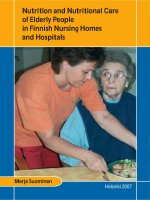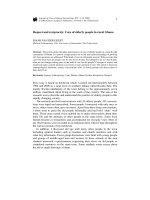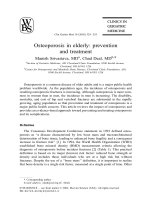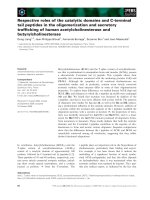The old age Personal Hygiene Of elderly people and Improvements potx
Bạn đang xem bản rút gọn của tài liệu. Xem và tải ngay bản đầy đủ của tài liệu tại đây (34.78 KB, 7 trang )
The old age Personal Hygiene Of elderly people and Improvements
Hamendra Singh
M. Des, IIT, New Delhi-110016
India
The finding of definition of old age is as interesting because the very nature of old
age is different from one person to another. The best definition that came up is:
“Continued in life; advanced in the course of existence; advanced far in years or life;
having lived till toward the end of the ordinary term of living ; designating the age of a
person or thing ”
The age distribution of the world’s population is changing. With advances in medicine
and prolonged life expectancy,the proportion of older people will continue to rise
worldwide. By 2050, there will be 2 billion people over the age of 60, 80% living in
developing countries. The growth in this population is staggering, posing tremendous
challenges in caring for this ageing population.
As people age , their susceptibility to chronic and life-threatening diseases as well as
acute infections increases, exacerbated by compromised immune systems. Cancer,
cardiovascular diseases, diabetes, infections and poor oral health, most notably tooth loss
and severe periodontal conditions, are more prevalent in this age group.
The consequences of these diseases and conditions are significant, leading to disabilities
and reduced quality of life. India is a vast country both in terms of area as well as
population. Today the population of old age is above 54.7 million, which is more than
half the total population. This is our responsibility to think and do about the people who
are dependent on the younger generation for support and affection. When they were
young, they bought us up with all they could and now they are old and needy and we it’s
the debt that we owe towards them and return with all we can.
Thus personal hygiene is most important of all the issues with elderly person, as the
hygienic person will probably not get ill and thus other miseries. We should also think
about the old people who are living in rural areas because more than four times as many
older persons live in the rural areas of India as in urban areas. Thus considering for old
age means focusing on all the issues that come up with this age to find a better solution.
The need for personal hygiene is the first priority that should be given because a healthy
and clean person will have a better living and others will prefer to be close to the person.
Personal hygiene involves cleansing of the body internally and externally. Classifying
each point of hygiene will give a better understanding of the subject and discuss them in
brief.
Bathing:
Physiologically, bathing allows cleansing of the skin and removal of accumulated foreign
matter. Bathing displaces dead skin, prevents irritations and rashes that would otherwise
transform into infections, and washes away waste materials that can interfere with the
normal functioning of the skin. Safety problems among the aged are generally due to the
loss of physical capabilities and poor design of bathing equipment. In order to
compensate for loss of capabilities, the elderly tend to over-exert themselves.
This seriously affects their security and personal well being. For example, the elderly
have difficulty bending over and kneeling down. They are unable to access parts of their
body when standing, and some even when sitting. The elderly are constrained by limited
reach and poor grip strength. They feel exerted by the poor design and location of
controls like tap and shower. They have problems reaching fixtures and grasping them.
Many receive injuries from applying excessive force. Poor balance affects stabilization.
Historically, the development of bathing equipment has been more of chance than
conscious design. First, these products are outdated and they fail to meet the physical
needs of the aging population. They point the need for alternative ways of bathing.
Second, bath stools and showers are ability specific products. They conform only to the
functional capabilities and physical needs of young, able-bodied individuals, and place
considerable physical and mental demands on the elderly, the children and those with
disabilities. For example, the positioning of controls and accessories often requires
standing and a wide range of motion. Showers require good balance while bathing. The
loss of reach from a person's restricted movement makes controls and accessories
inaccessible.
Thus for much of their lives, people either bathe in unsafe conditions or they are
dependent on assistance. Opening faucets and adjusting water temperature are
troublesome for many. Those who lack sensation in the hands frequently misjudge the
water temperature and get scalded. Low level of illumination makes it difficult for
bathers to see controls and accessories. Practically bathing is the hardest task for elderly
people. Standing while bathing in the absence of adequate grab-bars is the most common
of all unsafe practices. Most people ensure safety by being very careful about every
activity. The physical and mental stress adds to this while bathing, getting irritated easily
is a common problem.
Recommendations for Existing Bathrooms:
• Presence of sliding doors for the elderly people.
• Easy width of clearance.
• Make sure towels, soap and shampoo are within easy
reach. Bathing in a hurry can seriously jeopardize safety.
Allocate enough time to make transfers and when reaching
for articles. This will decrease psychological stress and
increase bathing pleasure.
• Install emergency devices such as beep or intercom within
easy reach of the users. These devices provide greater
personal security.
• Light colored walls in the bathroom.
• Alternative of bathing can be done like sponge bath.
• Storage: Storage of cloths and bathing items within easy
reach.
• Round all edges and soften all corners to reduce the
chances of injury in a fall
installing non-skid floors.
• Grab Bars: install widespread distribution of grab bars in
the form of handrails
strengthen soap holders or towel rods so that they can act
as invisible supports.
• Articles within Easy Grasp: To achieve this, position all
accessories and controls within comfortable reach.
Appropriately placed wall mounted storage greatly increase
reach. Their placement must be carefully examined and the
final location thoroughly tested on the basis of individual
needs.
• Prevent over exertions: elderly people get irritated and
exerted easily as such all care must be taken.
• Handheld Fixtures: Locate manual fixtures such as hand
held showers to combat the difficulties due to inflexible
positioning of tap/shower controls. Such fixtures will
greatly increase access and prevent physical strain from
over-extension.
• Bathing Devices: Devices such as wash mittens and bath
brushes can greatly increase access to parts of the body.
The wash mittens are usually made out of terry cloth,
plastic mesh or soft sponge. Bath brushes are available in
long, short or curved handles. They come with cloth head,
sponge tip or nylon bristles. Wash mittens and bath
brushes provide a person a great range of access and
bathing independence.
• After bathing be sure the person is thoroughly dry.
Moisturizer on dry legs and arms also helps prevent skin
tears and frail skin. Applying moisturizing lotion to the
person's skin can be a soothing experience for the elderly
person.
• Check toe / fingernails and trim them regularly.
Lavatory:
The use of toilets by elderly people is again a painful work. Elderly people especially
suffering from joint arthritis find it very difficult to use the toilets. The sitting
and standing thus becomes more painful. They walk all along the corners of the wall to
balance their body. The cleaning and balancing goes together. They do the change
of clothes in toilets with a limited movement space and a risk of falling down. The toilets
fail to meet the physical needs of the aging population. There is a need of alternative
means of using toilets. These toilets have been designed with all age groups people in
mind but the case of elderly people seem to have been neglected. The cleaning
of hands involve opening of tap and search for soaps, here again the hand movements are
shaky to gather foam, which can be better done by liquid soaps. The door has to
be opened with both the hands as such difficulty in body balance, walking within toilet is
not easy as there is a risk of slipping. The toilets are too low for the person to rise up
safely. Some people’s skin are too sensitive to be wiped with toilet paper (problems like
hemorrhoids, constant wiping, allergies to dioxins in paper, and more), and even
vision impairments make it difficult for users to know when they are clean.
Ageing involves a range of biochemical and physiological changes that affect all parts of
the body. Acute, but more often chronic illness, can increase the rate of degeneration
in a particular body system. Dietary fiber softens the stool provides bulk, hence
increasing the weight of the stool, and helps food pass more quickly through the gut.
Good sources of fiber are whole meal and high fiber white bread, wholegrain cereals,
whole meal flour, fruits and vegetables, beans and pulses. It is not advisable to take
bran in its raw form. Care must be taken when encouraging high fiber diets in elderly
people with poor appetites, as a small stomach can fill quickly and prevent them eating
enough high-energy food and micronutrients. Thus a good eating habit can keep the colon
clean and free from infections.
Recommendations for Existing Lavatory:
• Special toilets must be addressed to in such way that it not
a disabled toilet or an elderly toilet
• Self cleaning machanism should be developed for indian
toilet seats as well.
• Liquid soaps are better over soap bars for easy hand wash.
• Spacious toilets and support grab bars around the door are
desirable
• An alarm is desirable; it will increase the convenience of
the rest room
• The door lock should require little force (no friction)
• It should be possible to open and close the door lock with
one hand (other hand can be used for stability)
• Always wear low-heeled shoes with rubber soles for good
traction. Never wear slippers, shoes with leather soles or
high heels
• A locked/unlocked indicator on the inside of the rest room
is desirable
• The locking device inside the door must be placed above or
on the handle
Oral Hygiene:
The interrelationship between oral health and general health is particularly pronounced
among older people. Poor oral health can increase the risks to general health and, with
compromised chewing and eating abilities, affect nutritional intake. The maintenance of a
good oral health should include controlled eating habits, regular application of fluoride,
oral hygiene and regular dental examination. Other relevant issues include high sugar
content diets, inadequate oral hygiene due to poor dexterity, and alcohol and tobacco use,
risk factors that are detrimental to oral health. Elderly people use dentures, these are at
times ill fitting, and as such food contents remain in the spaces around them. The enamel
is weak and hence brushes need to be with soft bristles. The hands and muscles are weak
and difficult to brush at times. They may not like the taste of toothpaste. Oral health care
may not be always available at rural areas. Elder people prefer to use lesser water.
Medical conditions, such as dry mouth which reduces saliva's ability to wash away food,
neutralize plaque acids, and keep tooth enamel strong, and arthritis which makes it hard
to floss and brush.
Recommendations for Oral hygiene:
o A good rinse of the mouth or even a drink of water after meals helps to clear the mouth
of retained food particles, especially before replacing dentures. o Fluoride is very
important in the prevention of tooth decay. It encourages the tooth to reform following
the acid attack. Fluoride should be applied to the mouth of elderly people regularly, either
in the form of toothpaste, mouth rinses or spray. Rinses cannot be used as a substitute for
daily tooth brushing since daily removal of plaque is essential for maintaining a healthy
mouth. o Ayurvedic tooth powder can be applied on gums and teeth with finger massage,
to clean and strengthen muscles. The availability of neem tree barks is used as brush and
their powder used for tooth and gum massaging. o Need to develop some liquid cleanser
for teeth, by rinsing of mouth and no water needed. o Develop a taste of toothpaste that
the elderly people may enjoy to brush.
Clothing:
Clothing that is neat and clean, fits well, gives a feel of confidence. Older people are
often concerned about their appearance. Most people like clothing that is easy to
put on and take off. If a person needs help getting dressed and undressed, clothes that
goes on and come off easily help everyone concerned. Many times elderly people have
trouble raising their arms, bending or leaning. This makes getting dressed more painful,
and is frustrating for the caregiver, as well. Clothes that fit loosely without being
baggy are easier to get on and off. Features such as front openings, large zipper pulls,
hook-and loop tape closures, or wrap styles may help. Clothing that is chosen with
function in mind allows more comfortable movement in daily activities. While choosing
the product following points should be kept in mind, the wearer’s physical condition the
frequency of changing required convenience of changing purchase costs time required
and cost Clothing Comfort can be classified as:
Physical Comfort: Clothing protects people from humidity, heat, and cold, and helps
them feel physically comfortable. Characteristics of fabric that affect physical comfort
include flexibility, bulkiness, weight, and texture. Garment construction also affects
physical comfort.
Psychological comfort : Clothing gives the wearer a sense of well being. It tells
something about the person. Clothing also affects the way others see, think of, and react
to the person.
Social comfort :A person can be comfortable or uncomfortable wearing a
certain garment or type of clothing in a social situation. Social comfort may be involved
when a person wishes to “make an impression” through the clothing he or she wears.
The clothing should provide comfortable of movement, ease to wear it, and easy to wash.
Recommendation for better clothing:
• Waistlines loose enough to expand when the person is
seated. If the waist is elastic, be sure it does not cut. Large
neck openings.
• Accessible loose front pockets for carrying personal items.
• Use of soft cloth materials
• Winters can have loose woolen sweaters for men and
women with large neck and warm head coverings.
• ] Loose fitting clothes are more comfortable, and are
designed not to cause friction sores or bruising.
• Wider sleeves allow for greater ease of movement for men
and women.
• Colors are bright and cheerful, for a better sense of health
and well being.
• It should always bring dignity to the wearer, should ease
the pain of dressing, and save the caregiver time and
frustration.
• Use cardigans rather than pullovers, and other garments
with front openings.
• Choose a spot in the room for the person to dress and a
different spot for the person to get undressed and ready for
bed. Try to use the same spots every day.
For men:
Try pants with elastic waistbands
Tube socks are easier to put on, because they have no
heels.
T-Shirts tend to look okay even if worn backwards.
If snaps, hooks, zippers and belt buckles are too difficult to
manage, replace them with Velcro tape.
Velcro closures on shoes allow the width to be easily
adjusted for swelling.
Cloth materials should be little stretchable as well.
It is important to have good fitting shoes and slippers to
allow safe mobility
For women:
Try slip-on blouses, wrap-around or elastic waistband
skirts or slacks.
Front fastening bras are easier for you both to manage. Not
wearing a bra can cause soreness and discomfort;
however, a cotton vest may be considered if the person has
difficulty with a bra.
Older women can wear loose shalwar kameez rather than a
saaree, for easy dressing.
In summers loose t shirt and ghaagra can be worn for ease
of wearing and movements.
These aspects of personal hygiene indicate how important it is for the elderly people to be
hygienic. As a designer’s point of view, all the products are made in such a fashion
that incorporates the elderly people to some extent if not to the full extent. More and
more products can be innovated which improve the living condition and lifestyle
of the elderly people. They should be comforted with love and affection and the products
designed in a way that they accept to use happily. There is more physiologically and
incorporating emotional support and encouraging them to use the same must remove
emotional factor involved in personal hygiene and those fears of using the elements.
Hamendra Singh
IIT, New Delhi-110016
India
Source:









